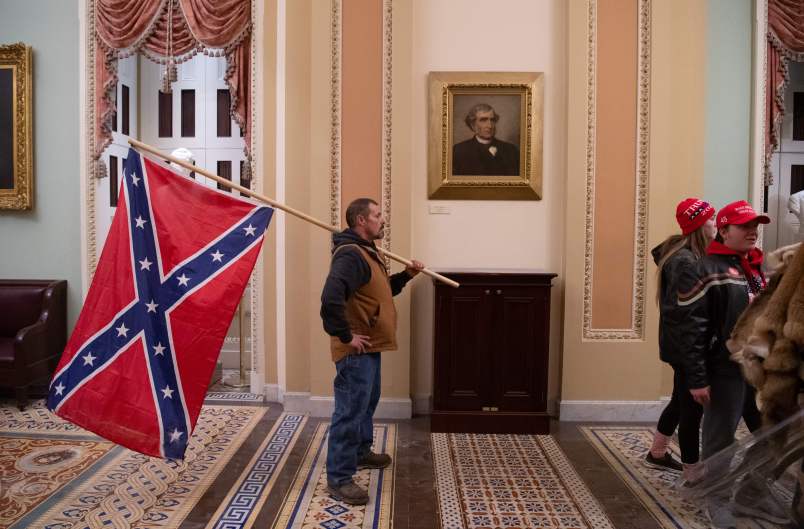The crowd was rushing in. Nearly everyone with the power to stop it seemed caught by surprise.
Now, more than a week after the stunning Jan. 6 attack on the U.S. Capitol, many former security officials remain mystified by one question: Why did the vast resources of federal law enforcement result in no threat assessment of what was coming?
It would have come in the form of a joint intelligence bulletin: a report prepared by the FBI and Homeland Security’s Office of Intelligence & Analysis that would have given Capitol police, D.C. cops, and others information about what was in store.
The bulletin itself is a nearly perfunctory assessment done before any major event, ranging from the Super Bowl to a large protest. One was reportedly issued on Jan. 13, in advance of the Biden inauguration.
The lack of such a bulletin in advance of Jan. 6 shocked former government officials.
Across conversations with multiple former DHS officials and analysts, TPM found that a top-down aversion from the Trump administration towards addressing the threat of far-right extremism, inept management, and the dismantling of DHS bureaucracies aimed at coordinating, analyzing, and disseminating information about extremist groups contributed to the lack of warning.
“Nobody wanted to write a formal intelligence report about this, in part out of fear that such a report would be very poorly received by the MAGA folks within DHS,” one former DHS official who served in the Trump administration told TPM, on condition of anonymity to speak freely.
The acting head of the FBI’s Washington field office defended the bureau’s preparation on Tuesday, saying that agents in part were tasked with sifting through months of online threats with no indication of what was puffery and what was real. NBC reported on Wednesday that that field office had received an “F” grade in an internal FBI evaluation on its ability to fight domestic terrorism.
Intelligence & Analysis
Multiple former officials described a climate of fear within DHS around reporting threats from the far right, specifically within the Department’s Office of Intelligence and Analysis (I&A).
I&A was created after 9/11 to process and share information and intelligence gathered by federal agencies at the state and local level.
Over the years, it became a lynchpin of national efforts to monitor domestic terrorist threats, analyze the information, and disseminate it to law enforcement around the country. That’s exactly the kind of information-sharing which would have resulted in a joint intelligence bulletin warning ahead of Jan. 6.
Elizabeth Neumann, a former DHS assistant secretary for threat prevention and security policy, pointed out that FBI and DHS produced a JIB before the deadly 2017 Charlottesville Unite the Right rally.
“Somebody was doing something back then, at least,” she said.
Neumann, who left DHS in April 2020 and endorsed Joe Biden in summer 2020, added that, in the years since 2017, DHS officials had steered I&A away from far-right extremism, leaving that issue to the FBI.
“That was a distinct shift from how DHS had operated in the past,” Neumann said.
MAGA fear
DHS’s deprioritization of far-right domestic terrorism has been well-documented over the years, as analysts in the unit were reassigned to cover other topics.
One whistleblower, who went to Congress after himself getting involved in a scandal in which the unit surveilled journalists, said that DHS officials had ordered him to stay away from the threat of white nationalism.
Former officials at DHS echoed the whistleblower’s comments, saying that a climate of fear had been instilled in the office which made intelligence officers want to “keep their heads down” for fear of their jobs.
When it came time to assess threats in advance of Jan. 6, former officials told TPM, the office had been conditioned to assume that the FBI — with its investigative reach and history prosecuting domestic terrorism cases — would have things under control.
“They wanted to rest on the idea that the affected law enforcement agencies would handle it,” one said.
The failure is broad and, as multiple officials pointed out, a core function of I&A’s mission.
“It would be correct to say that analysts within I&A and FBI were aware of groups coming to Washington and some more prominent individuals, but for reasons of fear didn’t want to formalize reports,” said the former high-ranking DHS official, adding that “there was a fear that that would be a career-limiting move.”
Overload
All of this has seriously depleted the government office responsible for coordinating and disseminating information about domestic terrorism threats.
The result was that, before Jan. 6, intelligence-sharing centers around the country did not receive information on what was coming.
“I had not received any national-level products prior to Jan. 6,” said Mike Sena, head of the National Fusion Center Association, a group representing the national network of intelligence-sharing offices created after 9/11 to ensure that DHS, DOJ, and FBI information flows around the country between the agencies and onwards to local law enforcement. “There wasn’t a push for information.”
Part of the failure had to do with the ubiquity of the threat. Former DHS officials told TPM that after years of Trump supporters mouthing off about violence online, it had gotten somewhat more difficult to distinguish between what was a real threat and what were paper tigers.
Steven D’Antuono, acting special agent in charge of the bureau’s Washington field office, echoed that defense on Wednesday, saying that agents had to “separate the aspirational from the intentional and determine which of the individuals saying despicable things on the internet are just practicing keyboard bravado or they actually have the intent to do harm.”
But Neumann, the former DHS official, argued that the intelligence failures that led to Jan. 6 were structural.
“When you have a bad day like America did on Jan. 6, it’s not that there aren’t good people at DHS trying to do their job, it’s that they’re not empowered,” she said.






